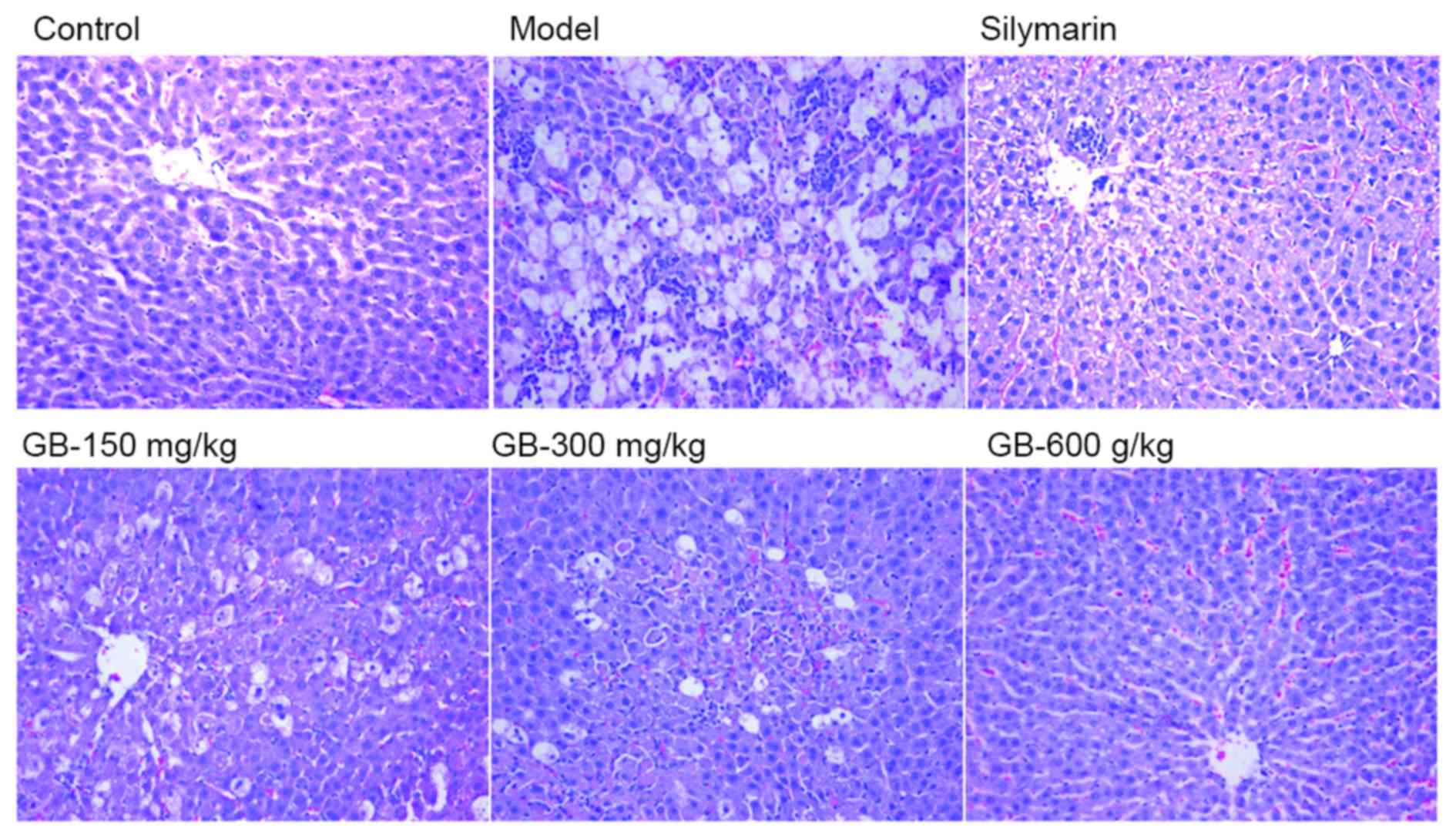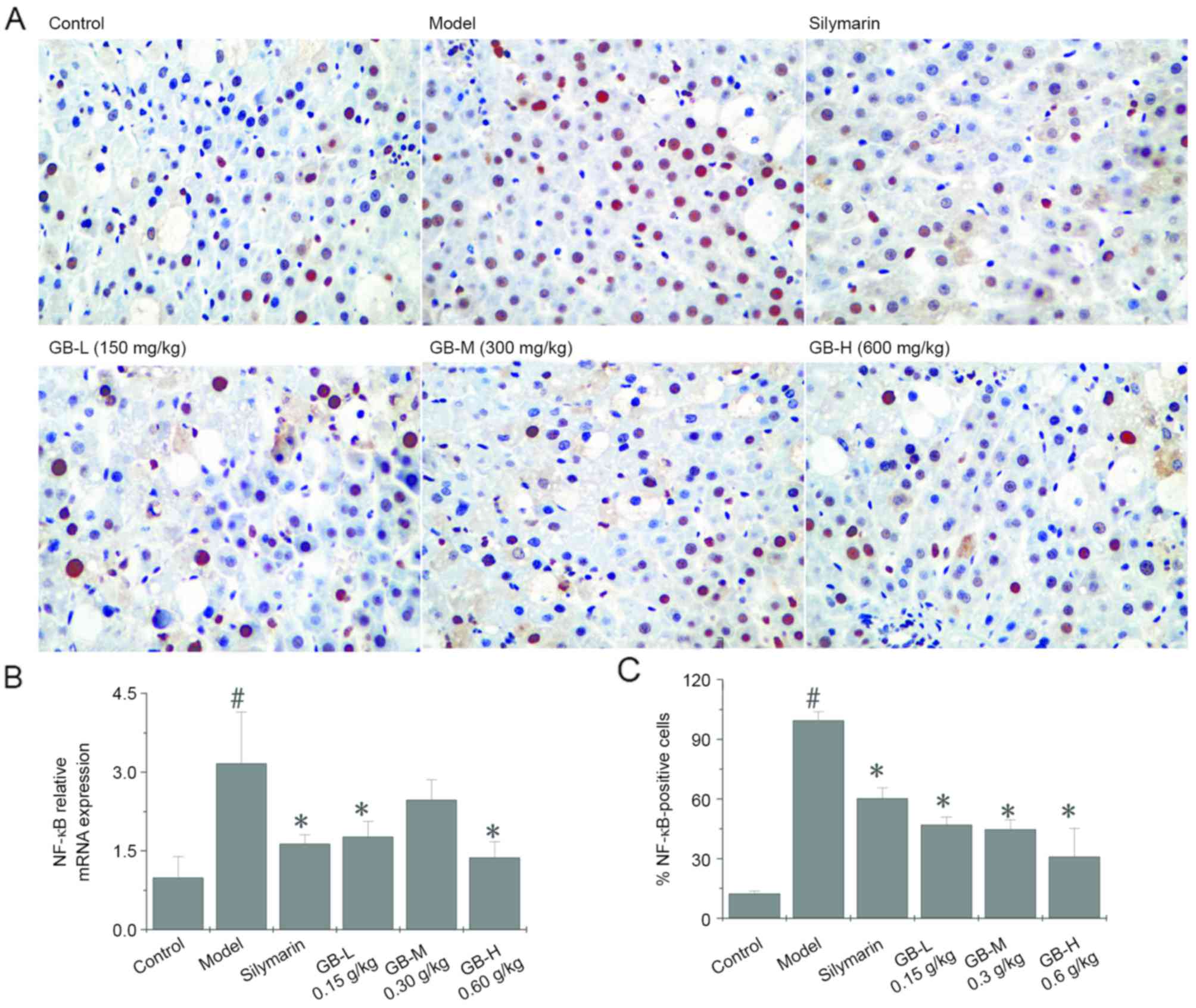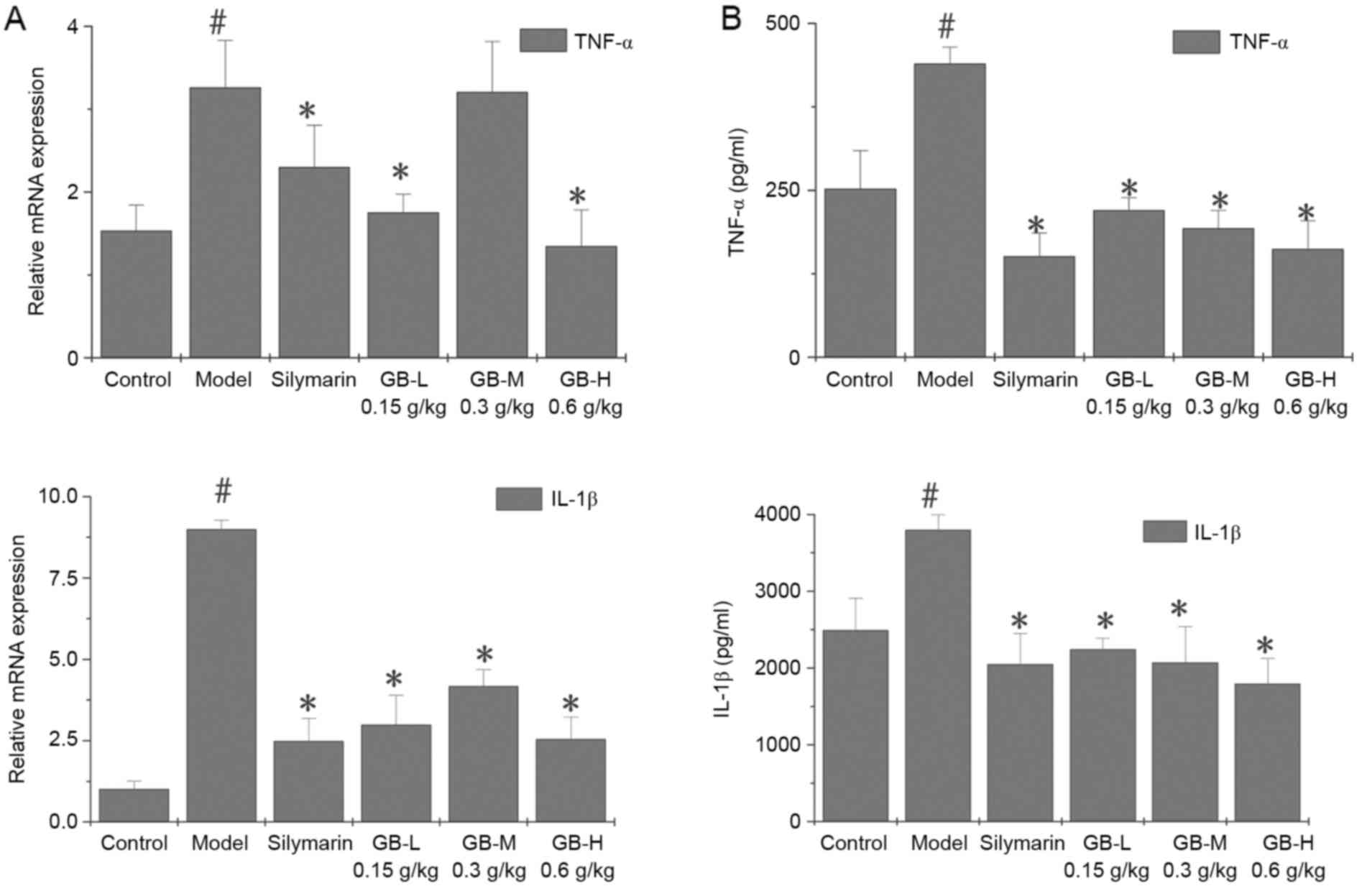|
1
|
Güven A, Güven A and Gülmez M: The effect
of kefir on the activities of GSH-Px, GST, CAT, GSH and LPO levels
in carbon tetrachloride-induced mice tissues. J Vet Med B Infect
Dis Vet Public Health. 50:412–416. 2003. View Article : Google Scholar : PubMed/NCBI
|
|
2
|
Ogeturk M, Kus I, Colakoglu N, Zararsiz I,
Ilhan N and Sarsilmaz M: Caffeic acid phenethyl ester protects
kidneys against carbon tetrachloride toxicity in rats. J
Ethnopharmacol. 97:273–280. 2005. View Article : Google Scholar : PubMed/NCBI
|
|
3
|
Jaramillo-Juárez F, Rodríguez-Vázquez ML,
Rincón-Sánchez AR, Consolación Martínez M, Ortiz GG, Llamas J,
Anibal Posadas F and Reyes JL: Acute renal failure induced by
carbon tetrachloride in rats with hepatic cirrhosis. Ann Hepatol.
7:331–338. 2008.PubMed/NCBI
|
|
4
|
Galligani L, Lonati-Galligani M and Fuller
GC: Collagen synthesis in explant cultures of normal and
CCl4-treated mouse liver. Toxicol Appl Pharmacol. 48:131–137. 1979.
View Article : Google Scholar : PubMed/NCBI
|
|
5
|
Recknagel RO, Glende EA Jr, Dolak JA and
Waller RL: Mechanisms of carbon tetrachloride toxicity. Pharmacol
Ther. 43:139–154. 1989. View Article : Google Scholar : PubMed/NCBI
|
|
6
|
Slater TF: Free-radical mechanisms in
tissue injury. Biochem J. 222:1–15. 1984. View Article : Google Scholar : PubMed/NCBI
|
|
7
|
Poli G: Liver damage due to free radicals.
Br Med Bull. 49:604–620. 1993. View Article : Google Scholar : PubMed/NCBI
|
|
8
|
Johnson SJ, Hines JE and Burt AD:
Macrophage and perisinusoidal cell kinetics in acute liver injury.
J Pathol. 166:351–358. 1992. View Article : Google Scholar : PubMed/NCBI
|
|
9
|
Sasaki S, Yoneyama H, Suzuki K, Suriki H,
Aiba T, Watanabe S, Kawauchi Y, Kawachi H, Shimizu F, Matsushima K,
et al: Blockade of CXCL10 protects mice from acute colitis and
enhances crypt cell survival. Eur J Immunol. 32:3197–3205. 2002.
View Article : Google Scholar : PubMed/NCBI
|
|
10
|
Kalinichenko VV, Bhattacharyya D, Zhou Y,
Gusarova GA, Kim W, Shin B and Costa RH: Foxf1 +/− mice
exhibit defective stellate cell activation and abnormal liver
regeneration following CCl4 injury. Hepatology.
37:107–117. 2003. View Article : Google Scholar : PubMed/NCBI
|
|
11
|
Steinman L, Martin R, Bernard C, Conlon P
and Oksenberg JR: Multiple sclerosis: Deeper understanding of its
pathogenesis reveals new targets for therapy. Annu Rev Neurosci.
25:491–505. 2002. View Article : Google Scholar : PubMed/NCBI
|
|
12
|
Morio LA, Chiu H, Sprowles KA, Zhou P,
Heck DE, Gordon MK and Laskin DL: Distinct roles of tumor necrosis
factor-alpha and nitric oxide in acute liver injury induced by
carbon tetrachloride in mice. Toxicol Appl Pharmacol. 172:44–51.
2001. View Article : Google Scholar : PubMed/NCBI
|
|
13
|
Weber LW, Boll M and Stampfl A:
Hepatotoxicity and mechanism of action of haloalkanes: Carbon
tetrachloride as a toxicological model. Crit Rev Toxicol.
33:105–136. 2003. View Article : Google Scholar : PubMed/NCBI
|
|
14
|
Miyazaki T, Bouscarel B, Ikegami T, Honda
A and Matsuzaki Y: The protective effect of taurine against hepatic
damage in a model of liver disease and hepatic stellate cells. Adv
Exp Med Biol. 643:293–303. 2009. View Article : Google Scholar : PubMed/NCBI
|
|
15
|
Kolios G, Valatas V and Kouroumalis E:
Role of Kupffer cells in the pathogenesis of liver disease. World J
Gastroenterol. 12:7413–7420. 2006. View Article : Google Scholar : PubMed/NCBI
|
|
16
|
Luckey SW and Petersen DR: Activation of
Kupffer cells during the course of carbon tetrachloride-induced
liver injury and fibrosis in rats. Exp Mol Pathol. 71:226–240.
2001. View Article : Google Scholar : PubMed/NCBI
|
|
17
|
Yang L, Magness ST, Bataller R, Rippe RA
and Brenner DA: NF-kappaB activation in Kupffer cells after partial
hepatectomy. Am J Physiol Gastrointest Liver Physiol.
289:G530–G538. 2005. View Article : Google Scholar : PubMed/NCBI
|
|
18
|
Ohkawa H, Ohishi N and Yagi K: Assay for
lipid peroxides in animal tissues by thiobarbituric acid reaction.
Anal Biochem. 95:351–358. 1979. View Article : Google Scholar : PubMed/NCBI
|
|
19
|
McCord JM and Fridovich I: Superoxide
dismutase. An enzymic function for erythrocuprein (hemocuprein). J
Biol Chem. 244:6049–6055. 1969.PubMed/NCBI
|
|
20
|
Beutler E, Duron O and Kelly BM: Improved
method for the determination of blood glutathione. J Lab Clin Med.
61:882–888. 1963.PubMed/NCBI
|
|
21
|
Suja SR, Latha PG, Pushpangadan P and
Rajasekharan S: Evaluation of hepatoprotective effects of
Helminthostachys zeylanica (L.) Hook against carbon
tetrachloride-induced liver damage in Wistar rats. J
Ethnopharmacol. 92:61–66. 2004. View Article : Google Scholar : PubMed/NCBI
|
|
22
|
Kwak JH, Kim HJ, Lee KH, Kang SC and Zee
OP: Antioxidative iridoid glycosides and phenolic compounds from
Veronica peregrina. Arch Pharm Res. 32:207–213. 2009.
View Article : Google Scholar : PubMed/NCBI
|
|
23
|
Abe Y, Hashimoto S and Horie T: Curcumin
inhibition of inflammatory cytokine production by human peripheral
blood monocytes and alveolar macrophages. Pharmacol Res. 39:41–47.
1999. View Article : Google Scholar : PubMed/NCBI
|
|
24
|
Drotman RB and Lawhorn GT: Serum enzymes
as indicators of chemically induced liver damage. Drug Chem
Toxicol. 1:163–171. 1978. View Article : Google Scholar : PubMed/NCBI
|
|
25
|
Wolf PL: Biochemical diagnosis of liver
disease. Indian J Clin Biochem. 14:59–90. 1999. View Article : Google Scholar : PubMed/NCBI
|
|
26
|
Cemek M, Aymelek F, Büyükokuroğlu ME,
Karaca T, Büyükben A and Yilmaz F: Protective potential of Royal
Jelly against carbon tetrachloride induced-toxicity and changes in
the serum sialic acid levels. Food Chem Toxicol. 48:2827–2832.
2010. View Article : Google Scholar : PubMed/NCBI
|
|
27
|
Cheeseman KH: Mechanisms and effects of
lipid peroxidation. Mol Aspects Med. 14:191–197. 1993. View Article : Google Scholar : PubMed/NCBI
|
|
28
|
Pompella A, Visvikis A, Paolicchi A, De
Tata V and Casini AF: The changing faces of glutathione, a cellular
protagonist. Biochem Pharmacol. 66:1499–1503. 2003. View Article : Google Scholar : PubMed/NCBI
|
|
29
|
Maritim AC, Sanders RA and Watkins JB III:
Effects of alpha-lipoic acid on biomarkers of oxidative stress in
streptozotocin-induced diabetic rats. J Nutr Biochem. 14:288–294.
2003. View Article : Google Scholar : PubMed/NCBI
|
|
30
|
Ramadori G and Armbrust T: Cytokines in
the liver. Eur J Gastroenterol Hepatol. 13:777–784. 2001.
View Article : Google Scholar : PubMed/NCBI
|
|
31
|
Simpson KJ, Lukacs NW, Colletti L,
Strieter RM and Kunkel SL: Cytokines and the liver. J Hepatol.
27:1120–1132. 1997. View Article : Google Scholar : PubMed/NCBI
|
|
32
|
Neuman MG: Cytokines-central factors in
alcoholic liver disease. Alcohol Res Health. 27:307–316.
2003.PubMed/NCBI
|
|
33
|
Oakley F, Mann J, Nailard S, Smart DE,
Mungalsingh N, Constandinou C, Ali S, Wilson SJ, Millward-Sadler H,
Iredale JP and Mann DA: Nuclear factor-kappaB1 (p50) limits the
inflammatory and fibrogenic responses to chronic injury. Am J
Pathol. 166:695–708. 2005. View Article : Google Scholar : PubMed/NCBI
|

















